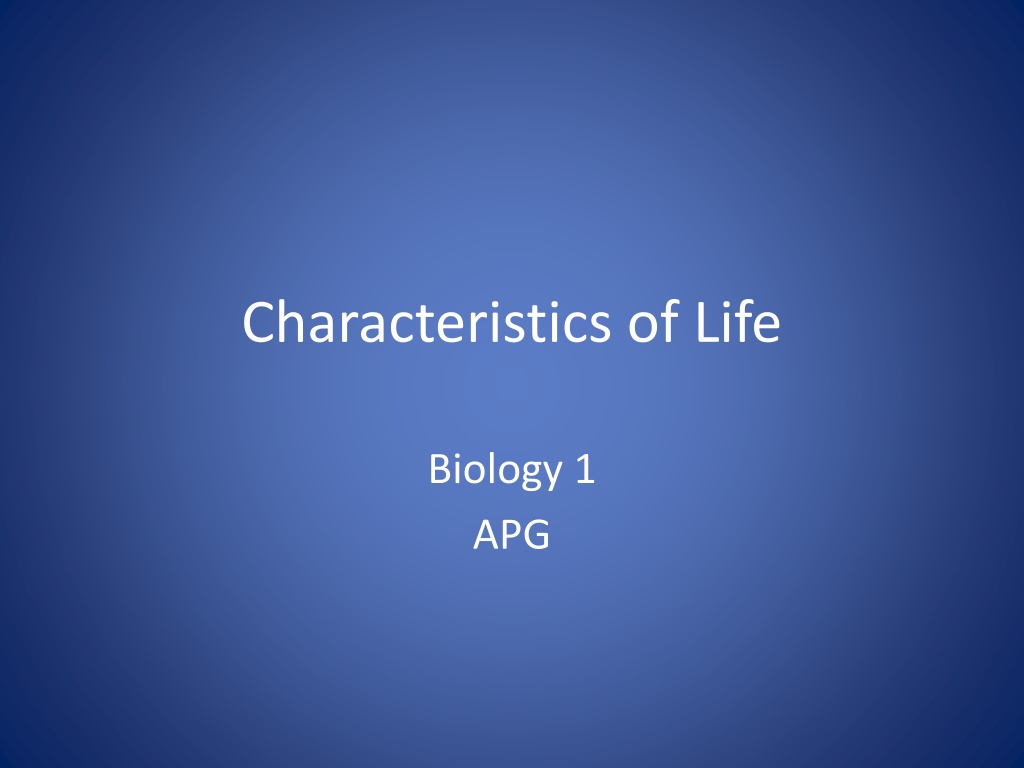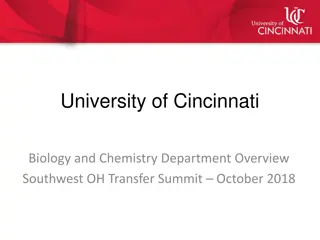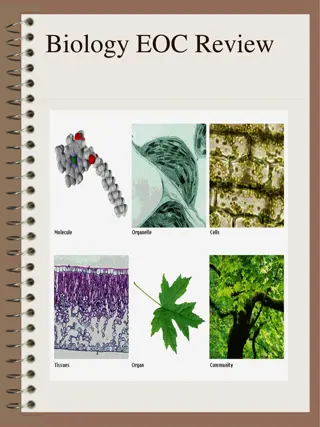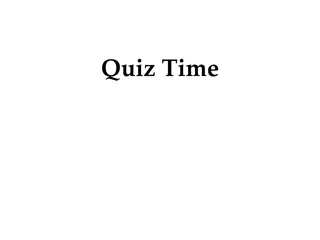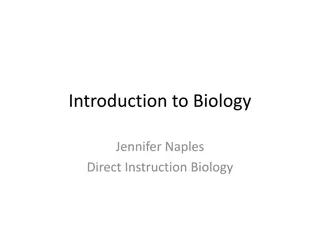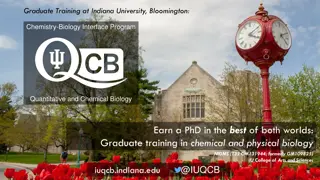Exploring Biology: Characteristics of Life and Chemistry Fundamentals
This informative content delves into the fundamental characteristics of life in biology, such as being made of cells, reproducing, evolving, organizing, metabolizing, and responding. It also provides insights into the basics of chemistry, covering matter, atoms, and elements. Engage in activities like a quick quiz on life characteristics and practice questions on atomic structure.
Download Presentation

Please find below an Image/Link to download the presentation.
The content on the website is provided AS IS for your information and personal use only. It may not be sold, licensed, or shared on other websites without obtaining consent from the author. Download presentation by click this link. If you encounter any issues during the download, it is possible that the publisher has removed the file from their server.
E N D
Presentation Transcript
Characteristics of Life Biology 1 APG
6 Characteristics Made of Cells - cells are the most basic unit of life, single cell organisms do exist Reproduce offspring must be produced before an organism dies so the species can live on Evolve change over time, pass on beneficial traits so the next generation is better off Organization individual cells have organization, entire organism has organization (ex: body systems) Metabolize needs, uses, and processes energy/food to grow and repair Respond will make changes in response to something in the environment
6 Characteristics of Living Things Made of Cells Reproduce Evolve Organization Metabolize Respond rock wood frog leaf worm cactus door paper grass water tree book elk bicycle human bacteria
Do Now! 10/20 Get your folder. In the Do Now section, write down the main idea of the question and the full answer. 1. Which of the following is NOT a characteristic of life? A) Living things are adapted to a particular way of life. B) Living things respond to stimuli. C) Living things reproduce. D) Living things have an internal (inside) environment that stays absolutely constant. 2. Food provides nutrient molecules, which are used either as building blocks or for ______. A) evolution B) reproduction C) response D) metabolism
Chemistry in Biology Chemistry = The study of changes in matter Matter = Anything that: a) Occupies space [volume] b) Has mass [weight]
Atoms Are the building blocks of matter Atoms, are made up of: n 0(in nucleus) Neutrons (no charge) p+ (in nucleus) Protons (positive charge) e- Electrons (negative charge)
Practice 1. Which part of an atom has a positive charge? a. Electrons b. Neutrons c. Nucleus d. Protons 2. Which part of an atom circles or orbits around the outside? a. Electrons b. Neutrons c. Neutral charge d. Positive charge
Elements Pure substances (composed of all the same kinds of atoms) that cannot be broken down by physical or chemical means. Identified in the Periodic Table
118 Elements 92 Naturally Occurring All matter both living and non-living found in the table
Molecules Two or more of the SAME atoms that join together chemically
Compounds Two or more DIFFERENT elements that are chemically combined (Bonded)
Practice 1. An element is a pure substance in which there are how many kinds of atoms? A) two kinds of atoms B) four kinds of atoms C) three kinds of atoms D) one kind of atom 2. Which of the following is an example of an element? a. H2 b. H2O c. CO2 d. C6H12O6
Types or Size of Molecules Monomer- one molecule, compound or atom. One single sub-unit Polymer- two or more monomers bonded together
6 elements in ALL Living things: C H N O P S ulfur arbon* ydrogen* * = most abundant in living things itrogen* xygen* hosphorus
Biomolecule Biomolecule- a molecule produced by a living organism, will have carbon in it and other elements from CHNOPS (sometimes referred to as organic compounds)
Practice Put the following letters in order of the acronym. P N C O H S
What do ALL Biomolecules have? Carbon Because Can form 4 bonds Forms neutral compounds (not charged) Forms long chains and branches, and rings BIG macromolecules
Practice Match the terms with the correct definition. Write the number and answer. 1. Two or more different types of atoms bonded together. 2. A pure substance with all the same type of atoms 3. Two or more monomers bonded together 4. Two or more of the same type of atoms bonded together 5. A molecule produced by a living thing 6. Has mass and volume 7. One single sub-unit Biomolecule Compound Element Matter Molecule Monomer Polymer
Do Now! 10/21 Get your folder. In the Do Now section, write down the main idea of the question and the full answer. 1. The nucleus of an atom contains: a. Electrons and Neutrons b. Neutrons and Protons c. Positive and negative charges d. All neutral particles 2. Two or more different elements bonded together is a: a. Atom b. Compound c. Element d. molecule
Do Now! 10/21 Get your folder. In the Do Now section, answer the questions in complete sentences. 1. What element is present in all Biomolecules and is central in their structure? 2. What is a synonym for biomolecules? 3. What does macro mean?
Do Now! 10/22 Get your folder. In the Do Now section, write down the main idea of the question and the full answer. 1. Which are the four most abundant elements in living cells? a. carbon, oxygen, nitrogen, sulfur b. carbon, oxygen, hydrogen, nitrogen c. carbon, oxygen, sulfur, phosphorus d. carbon, sulfur, hydrogen, magnesium 1. _______ is a molecule and ________ is a compound. a. H2O, CO2 b. O2, H2 c. O2, CO2 d. CO2, H2O
Do Now! 9/26 Get your folder and page 1 of the SWH. THINK: ANSWER #1 on the SWH. What do you think is the best way to lose weight? (In other words If you were to diet, how would you do it? What is the best diet?) Write your answer in complete sentences. PAIR: Discuss your answer with your tablemate. SHARE: Let s discuss as a class.
Do Now! 10/23 Get your folder. In the Do Now section, write down the main idea of the question and the full answer. 1. Amino Acids are to protein as _______________? A. Fatty acid and glycerol are to lipid B. DNA is to RNA C. Simple sugars are to starch D. monosaccharides are to fat 2. What is the monomer of carbohydrates? A. Amino acids B. Nucleotides C. Fatty acid D. monosaccharide
Do Now! 10/23 cont. Get your folder. In the Do Now section, write down the main idea of the question and the full answer. 1. What characteristics make carbon a good atom to use in macromolecules? Forms 4 bonds with other atoms Forms molecules with charges Forms small molecules with no more than 3 carbons Forms bonds with only other carbons and hydrogen 2. If you are stranded on an island which macromolecule would you want to be able to consume (eat)? a. Carbohydrates b. Lipids c. Nucleic Acids d. Proteins a. b. c. d.
Macromolecules Carbohydrates Proteins Lipids/Fats Nucleic Acids
Carbohydrates (sugars and starches) Used for energy storage and production Carbohydrate- an organic compound made of carbon, hydrogen, and oxygen (C H2O) Made of simple sugars such as fructose and glucose Monosaccharides- single sugar molecule Ex: glucose, fructose, galactose Disaccharide- 2 monosaccharides (2 sugars), Ex: sucrose or table sugar
Polysaccharides- many sugars, complex carbohydrates ex: starch or cellulose Starch- energy storage compound, important food source for animals/humans Cellulose- gives plant cell walls their structure/support, used in wood and cotton fibers
Lipids (fats and oils) Best energy storage compound 3 to 4 x s more Lipids are composed of carbon, hydrogen and oxygen Lipids- fats, oils, or waxes-fat like compounds A fat molecule is made of 1 glycerol molecule and 3 fatty acid molecules
1 gram of fat has 3 to 4 times as much energy as 1 gram of carbohydrates so it s a more efficient storage compound Cholesterol- a lipid that is important to the structural component of cells -it also makes hormones for the body (estrogen and testosterone) -can be bad when there is too much (heart disease)
Phospholipid type of lipid that makes up the cell membrane in all cells http://studentweb.usq.edu.au/home/U1013108/biotutor/images/PLB.jpg
Proteins Amino Acid- building block of proteins, 20 different amino acids, all have C, H, O, and N and some contain Sulfur 2 Functions: structural components of cells or acts as an enzymes (function in chemical reactions) Some proteins build body parts such as muscle, bone, hair and feathers
To synthesize (make) a protein -> 2 or more amino acids link together Peptide bonds hold the amino acids together Polypeptide- long chain of amino acids Thousands of different proteins are made out of these 20 amino acids number and combination of amino acids. Green plants can make all of the amino acids Animals and people cannot, which is why we have to eat a variety of foods to acquire them
Nucleic Acids A series of nucleotides linked together makes a nucleic acid Nucleotide- is made up of a phosphate group, 5- carbon sugar, and nitrogen base. (CHNOP)
Two types of Nucleic acids 1. RNA- ribonucleic acid -required for the synthesis (making) of proteins 2. DNA- deoxyribonucleic acid -determines genetic and hereditary information
Practice Place the terms into the correct boxes. Carbohydrate Lipid Amino Acid Nucleotide Monosaccharide Glycerol & 3 Fatty Acids DNA & RNA Fats & Oils Sugars Meat & beans CHO CHO CHNOP CHON (S) Cellulose Cholesterol Phosphate, Nitrogen Base & Sugar Plants make all 20 Nucleic Acid Protein
Lipid Carbohydrate Nucleic Acid Protein
Biomolecule Quiz Match the correct biomolecule(s) with the following terms or statements*: *(You may use more than one letter per question.) 1. Amino Acid________________ 2. Basic Formula CH2O________ 3. Contains 2-3x more energy than other biomolecules__________ 4. Contains the elements CHO in its structure________________ 5. Stores and transmits genetic information________________ 6. Monosaccharide_____________ 7. Glycerol + 3 Fatty Acids______ 8. Made up of Nucleotides_______ 9. Peptides Bonds______________ 10. Stores energy in covalent bonds______________________ a) Carbohydrate b) Lipid c) Protein d) Nucleic Acid
Matching Practice 1. Sugar that gives plant cell walls their structure 2. 2 or more monomers put together 3. Makes up the cell membrane of all cells 4. Carries genetic information 5. 2 sugars 6. Required for the synthesis of proteins 7. Holds together two amino acids 8. Lipid that is an important component of cell structure, makes hormones 9. Many sugars 10.A single sub-unit (building block) Cellulose Cholesterol Disaccharide DNA monomer Peptide Bond Phospholipid Polymer Polysaccharide RNA
Isotopes are atoms of elements with a different number of neutrons 12 14 6 p+ 6 p+ Carbon Carbon 6 e- 6 e- 8 n0 6 n0 Radioactive Isotopes Give off radiation (neutrons)
